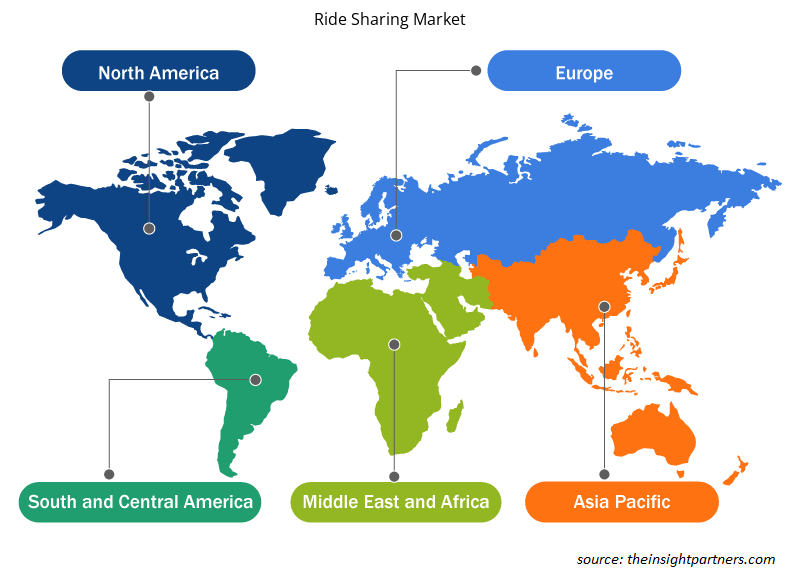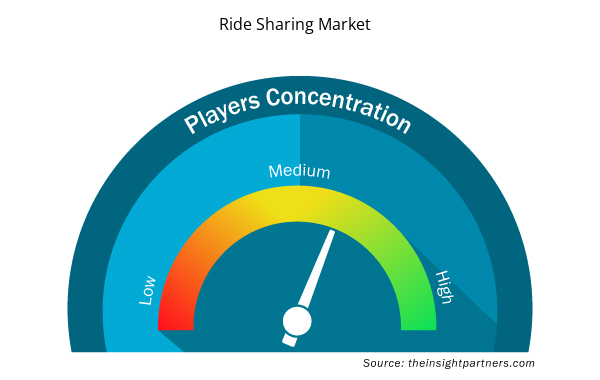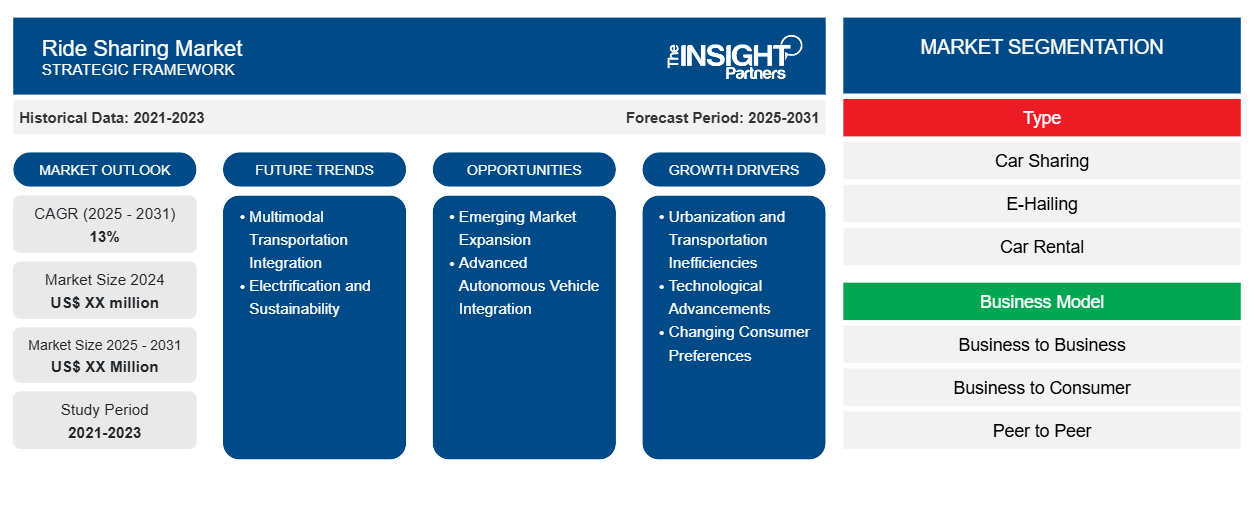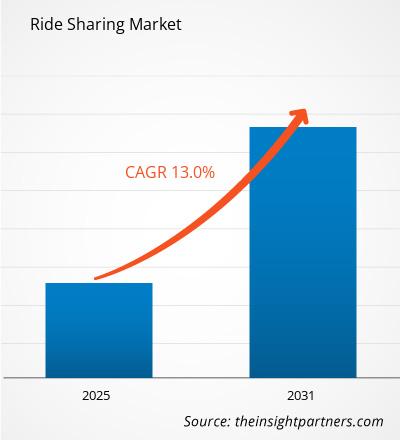ライドシェアリング市場は、2023年から2031年にかけて13%のCAGRで成長すると予想されており、市場規模は2023年のXX百万米ドルから2031年にはXX百万米ドルに拡大する見込みです。
レポートは、タイプ(カーシェアリング、E-Hailing、レンタカー)およびビジネスモデル(ビジネスツービジネス(B2B)、ビジネスツーコンシューマー(B2C)、ピアツーピア(P2P))別にセグメント化されています。グローバル分析は、地域レベルと主要国別にさらに細分化されています。レポートは、上記の分析とセグメントに対して米ドルでの価値を提供します。
報告書の目的
The Insight Partners によるライドシェアリング市場レポートは、現在の状況と将来の成長、主な推進要因、課題、機会を説明することを目的としています。これにより、次のようなさまざまなビジネス関係者に洞察が提供されます。
- テクノロジープロバイダー/メーカー: 進化する市場の動向を理解し、潜在的な成長機会を把握することで、情報に基づいた戦略的意思決定が可能になります。
- 投資家: 市場の成長率、市場の財務予測、バリュー チェーン全体に存在する機会に関する包括的な傾向分析を実施します。
- 規制機関: 市場の濫用を最小限に抑え、投資家の信用と信頼を維持し、市場の完全性と安定性を維持することを目的として、市場における政策と警察活動を規制します。
ライドシェアリング市場のセグメンテーション
タイプ
- カーシェアリング
- 電子呼び出し
- レンタカー
ビジネスモデル
- ビジネスツービジネス
- ビジネスから消費者へ
- ピアツーピア
要件に合わせてレポートをカスタマイズする
このレポートの一部、国レベルの分析、Excelデータパックなど、あらゆるレポートを無料でカスタマイズできます。また、スタートアップや大学向けのお得なオファーや割引もご利用いただけます。
- このレポートの主要な市場動向を入手してください。この無料サンプルには、市場動向から見積もりや予測に至るまでのデータ分析が含まれます。
ライドシェア市場の成長要因
- 都市化と交通の非効率性: 急速な世界的都市化により、人口密度の上昇、交通渋滞、駐車スペースの不足など、交通面での大きな課題が生じています。従来の交通モデルでは、現代の都市住民のダイナミックなモビリティ ニーズを満たすのに苦労しています。ライド シェアリング プラットフォームは、効率的でコスト効率の高い代替交通手段を提供することで、個人の自動車所有を減らし、既存の車両容量を最適化することで、都市のモビリティの制約に対処する柔軟なオンデマンド ソリューションを提供します。
- 技術の進歩: GPS、スマートフォンの普及、高度なアルゴリズムなどの画期的な技術により、ライドシェアリングの機能が一変しました。機械学習とリアルタイムのデータ分析により、より正確なルート最適化、動的な価格設定、ユーザーマッチングの強化が可能になります。これらの技術革新により、ユーザーエクスペリエンスが劇的に向上し、ライドシェアリングは従来の交通手段よりも便利で安全、かつ予測可能になりました。
- 消費者の嗜好の変化: 若い世代、特にミレニアル世代と Z 世代では、交通手段の嗜好が大きく変化しています。所有よりもアクセスを優先し、利便性を重視し、環境への意識も高まっています。この世代は、ライドシェアリングを、個人の自動車所有に伴う金銭的負担やメンテナンス負担を避け、ライフスタイルに合った持続可能で柔軟なモビリティ ソリューションとみなす傾向が高まっています。
ライドシェア市場の今後の動向
- マルチモーダル輸送の統合: ライドシェアリング プラットフォームは、個々の輸送サービスを超えて進化し、複数の移動オプションを統合されたシームレスなエコシステムに統合しています。企業は、ライドヘイリング、自転車シェアリング、電動スクーター、公共交通機関を統合したユーザーフレンドリーなアプリケーションに統合した包括的な輸送ソリューションを開発しています。モビリティ アズ ア サービス (MaaS) へのこの傾向により、ユーザーはより柔軟で相互接続された輸送の選択肢を利用できるようになります。
- 電動化と持続可能性: ライドシェアリング業界では、二酸化炭素排出量を削減し、高まる環境持続可能性への期待に応えるために、電気自動車やハイブリッド自動車の技術を急速に取り入れています。大手プラットフォームは、電気自動車の車両群に投資し、カーボンオフセット プログラムを実施し、ドライバーに環境に優しい輸送技術を採用するよう促すインセンティブ構造を開発しています。この傾向は、環境に配慮したモビリティ ソリューションに対する消費者の需要の高まりを反映しています。
ライドシェアリング市場の機会
- 新興市場の拡大: 発展途上国では、ライドシェアリング プラットフォームに大きな成長のチャンスがあります。東南アジア、インド、アフリカの一部などの地域では、急速な都市化、スマートフォンの普及率の上昇、中流階級の増加により、革新的なモビリティ ソリューションの土壌が生まれています。これらの市場は、ライドシェアリング企業が早期に市場リーダーシップを確立し、地域固有の交通エコシステムを開発するための未開拓の可能性を提供します。
- 高度な自動運転車の統合: 自動運転車技術の継続的な開発は、ライドシェアリング プラットフォームに変革の機会をもたらします。自動運転車のインフラストラクチャに投資して準備することで、企業は輸送経済に革命を起こす可能性があります。人件費の削減、安全性の向上、運用効率の向上により、ライドシェアリング環境が劇的に変化し、より手頃な価格で利用しやすいモビリティ ソリューションが提供されるようになります。
ライドシェアリング市場の地域別分析
予測期間を通じてライドシェアリング市場に影響を与える地域的な傾向と要因は、Insight Partners のアナリストによって徹底的に説明されています。このセクションでは、北米、ヨーロッパ、アジア太平洋、中東、アフリカ、南米、中米にわたるライドシェアリング市場のセグメントと地理についても説明します。

- ライドシェアリング市場の地域別データを入手
ライドシェアリング市場レポートの範囲
| レポート属性 | 詳細 |
|---|---|
| 2023年の市場規模 | XX百万米ドル |
| 2031年までの市場規模 | XX百万米ドル |
| 世界のCAGR(2023年~2031年) | 13% |
| 履歴データ | 2021-2022 |
| 予測期間 | 2024-2031 |
| 対象セグメント | タイプ別
|
| 対象地域と国 | 北米
|
| 市場リーダーと主要企業プロフィール |
|
ライドシェアリング市場のプレーヤー密度:ビジネスダイナミクスへの影響を理解する
ライドシェアリング市場は、消費者の嗜好の変化、技術の進歩、製品の利点に対する認識の高まりなどの要因により、エンドユーザーの需要が高まり、急速に成長しています。需要が高まるにつれて、企業は提供内容を拡大し、消費者のニーズを満たすために革新し、新たなトレンドを活用し、市場の成長をさらに促進しています。
市場プレーヤー密度とは、特定の市場または業界内で活動している企業または会社の分布を指します。これは、特定の市場スペースに、その市場規模または総市場価値に対してどれだけの競合相手 (市場プレーヤー) が存在するかを示します。
ライドシェア市場で事業を展開している主要企業は次のとおりです。
- ANIテクノロジーズ株式会社
- ブラブラカー
- カーマテクノロジー株式会社
- DiDi (北京小居科技有限公司)
- ゲット株式会社
免責事項:上記の企業は、特定の順序でランク付けされていません。

- ライドシェアリング市場のトップキープレーヤーの概要を入手
主なセールスポイント
- 包括的なカバレッジ: レポートでは、ライドシェアリング市場の製品、サービス、タイプ、エンドユーザーの分析を包括的にカバーし、全体的な展望を提供します。
- 専門家による分析: レポートは、業界の専門家とアナリストの深い理解に基づいてまとめられています。
- 最新情報: このレポートは、最新の情報とデータの傾向を網羅しているため、ビジネスの関連性を保証します。
- カスタマイズ オプション: このレポートは、特定のクライアント要件に対応し、ビジネス戦略に適切に適合するようにカスタマイズできます。
したがって、ライドシェアリング市場に関する調査レポートは、業界のシナリオと成長の見通しを解読し理解する道の先導役となることができます。正当な懸念事項がいくつかあるかもしれませんが、このレポートの全体的な利点は欠点を上回る傾向があります。
- 過去2年間の分析、基準年、CAGRによる予測(7年間)
- PEST分析とSWOT分析
- 市場規模価値/数量 - 世界、地域、国
- 業界と競争環境
- Excel データセット



Report Coverage
Revenue forecast, Company Analysis, Industry landscape, Growth factors, and Trends

Segment Covered
This text is related
to segments covered.

Regional Scope
North America, Europe, Asia Pacific, Middle East & Africa, South & Central America

Country Scope
This text is related
to country scope.
よくある質問
Some of the customization options available based on the request are an additional 3-5 company profiles and country-specific analysis of 3-5 countries of your choice. Customizations are to be requested/discussed before making final order confirmation, as our team would review the same and check the feasibility.
The report can be delivered in PDF/PPT format; we can also share excel dataset based on the request.
The leading players operating in the Ride Sharing Market include: Uber Technologies, Inc., Lyft, Inc., Didi Global Inc., Ola Cabs, Bolt (formerly Taxify), Grab Holdings,
Gojek, BlaBlaCar, Via Transportation, Inc., Cabify
The Ride Sharing Market is estimated to witness a CAGR of 13% from 2023 to 2031
Trend Toward Multimodal Solutions for Transportation is the key future trend of the Ride Sharing Market
The major factors driving the Ride Sharing Market are: Urbanization and Traffic Congestion#Rising Fuel Costs and Environmental Concerns
Trends and growth analysis reports related to Automotive and Transportation : READ MORE..
1. ANI Technologies Pvt. Ltd.
2. BlaBlaCar
3. Carma Technology Corporation
4. DiDi (Beijing Xiaoju Technology Co, Ltd.)
5. Gett, Inc.
6. Grab
7. Lyft, Inc.
8. Car2Go
9. Uber Technologies Inc.
10. Quick Ride
The Insight Partners performs research in 4 major stages: Data Collection & Secondary Research, Primary Research, Data Analysis and Data Triangulation & Final Review.
- Data Collection and Secondary Research:
As a market research and consulting firm operating from a decade, we have published and advised several client across the globe. First step for any study will start with an assessment of currently available data and insights from existing reports. Further, historical and current market information is collected from Investor Presentations, Annual Reports, SEC Filings, etc., and other information related to company’s performance and market positioning are gathered from Paid Databases (Factiva, Hoovers, and Reuters) and various other publications available in public domain.
Several associations trade associates, technical forums, institutes, societies and organization are accessed to gain technical as well as market related insights through their publications such as research papers, blogs and press releases related to the studies are referred to get cues about the market. Further, white papers, journals, magazines, and other news articles published in last 3 years are scrutinized and analyzed to understand the current market trends.
- Primary Research:
The primarily interview analysis comprise of data obtained from industry participants interview and answers to survey questions gathered by in-house primary team.
For primary research, interviews are conducted with industry experts/CEOs/Marketing Managers/VPs/Subject Matter Experts from both demand and supply side to get a 360-degree view of the market. The primary team conducts several interviews based on the complexity of the markets to understand the various market trends and dynamics which makes research more credible and precise.
A typical research interview fulfils the following functions:
- Provides first-hand information on the market size, market trends, growth trends, competitive landscape, and outlook
- Validates and strengthens in-house secondary research findings
- Develops the analysis team’s expertise and market understanding
Primary research involves email interactions and telephone interviews for each market, category, segment, and sub-segment across geographies. The participants who typically take part in such a process include, but are not limited to:
- Industry participants: VPs, business development managers, market intelligence managers and national sales managers
- Outside experts: Valuation experts, research analysts and key opinion leaders specializing in the electronics and semiconductor industry.
Below is the breakup of our primary respondents by company, designation, and region:

Once we receive the confirmation from primary research sources or primary respondents, we finalize the base year market estimation and forecast the data as per the macroeconomic and microeconomic factors assessed during data collection.
- Data Analysis:
Once data is validated through both secondary as well as primary respondents, we finalize the market estimations by hypothesis formulation and factor analysis at regional and country level.
- Macro-Economic Factor Analysis:
We analyse macroeconomic indicators such the gross domestic product (GDP), increase in the demand for goods and services across industries, technological advancement, regional economic growth, governmental policies, the influence of COVID-19, PEST analysis, and other aspects. This analysis aids in setting benchmarks for various nations/regions and approximating market splits. Additionally, the general trend of the aforementioned components aid in determining the market's development possibilities.
- Country Level Data:
Various factors that are especially aligned to the country are taken into account to determine the market size for a certain area and country, including the presence of vendors, such as headquarters and offices, the country's GDP, demand patterns, and industry growth. To comprehend the market dynamics for the nation, a number of growth variables, inhibitors, application areas, and current market trends are researched. The aforementioned elements aid in determining the country's overall market's growth potential.
- Company Profile:
The “Table of Contents” is formulated by listing and analyzing more than 25 - 30 companies operating in the market ecosystem across geographies. However, we profile only 10 companies as a standard practice in our syndicate reports. These 10 companies comprise leading, emerging, and regional players. Nonetheless, our analysis is not restricted to the 10 listed companies, we also analyze other companies present in the market to develop a holistic view and understand the prevailing trends. The “Company Profiles” section in the report covers key facts, business description, products & services, financial information, SWOT analysis, and key developments. The financial information presented is extracted from the annual reports and official documents of the publicly listed companies. Upon collecting the information for the sections of respective companies, we verify them via various primary sources and then compile the data in respective company profiles. The company level information helps us in deriving the base number as well as in forecasting the market size.
- Developing Base Number:
Aggregation of sales statistics (2020-2022) and macro-economic factor, and other secondary and primary research insights are utilized to arrive at base number and related market shares for 2022. The data gaps are identified in this step and relevant market data is analyzed, collected from paid primary interviews or databases. On finalizing the base year market size, forecasts are developed on the basis of macro-economic, industry and market growth factors and company level analysis.
- Data Triangulation and Final Review:
The market findings and base year market size calculations are validated from supply as well as demand side. Demand side validations are based on macro-economic factor analysis and benchmarks for respective regions and countries. In case of supply side validations, revenues of major companies are estimated (in case not available) based on industry benchmark, approximate number of employees, product portfolio, and primary interviews revenues are gathered. Further revenue from target product/service segment is assessed to avoid overshooting of market statistics. In case of heavy deviations between supply and demand side values, all thes steps are repeated to achieve synchronization.
We follow an iterative model, wherein we share our research findings with Subject Matter Experts (SME’s) and Key Opinion Leaders (KOLs) until consensus view of the market is not formulated – this model negates any drastic deviation in the opinions of experts. Only validated and universally acceptable research findings are quoted in our reports.
We have important check points that we use to validate our research findings – which we call – data triangulation, where we validate the information, we generate from secondary sources with primary interviews and then we re-validate with our internal data bases and Subject matter experts. This comprehensive model enables us to deliver high quality, reliable data in shortest possible time.


 このレポートの無料サンプルを入手する
このレポートの無料サンプルを入手する